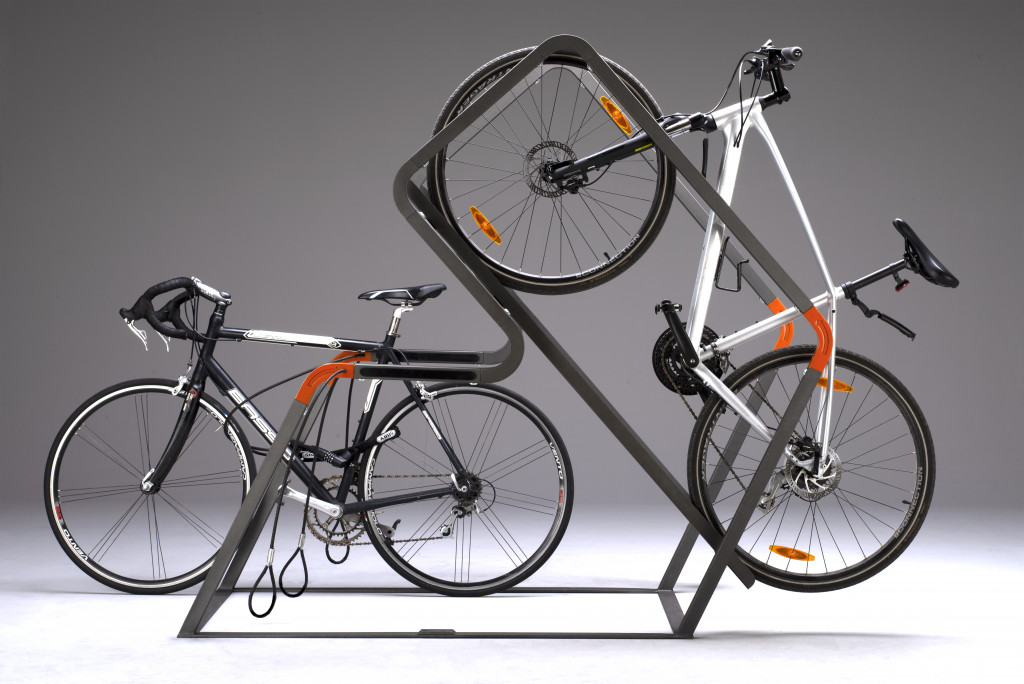MBF52
BA Major Design – Graduation Project
2022.3

MBF52
//
Modularer Baukasten Fahrradständer – Modular constructable bicycle rack
Mobility is the weave of our cities. Its infrastructure characterizes the urban landscape and, like the traffic lights of East Berlin, gives it an identity through their repeated appearances. Microarchitectures of public spaces, however, mostly have pedestrians as their main target group. From public toilets, to drinking fountains – also in the past the design targeted pedestrians. But as the Danish urban planner and architect Jan Gehl claims, in a “human scaled” city, cyclists and pedestrians should be arranged within the same category. Sustainable mobility in cities should be by foot, public transport and via bicycle. However, some means of the latter medium has the need to be parked when not in use. This thesis deals with exactly that problem: developing a safe, space-efficient and completely free-of-charge bicycle parking facility. Through precise research methods and testing across one-to-one models, the bicycle stand MBF52 was developed: a modular bicycle parking system which, by virtue of its coloured elements and dynamic shape, offers the possibility to park bikes compactly with maximum safety.
//
Die Mobilität ist das Geflecht unserer Städte. Dessen Infrastrukturen kennzeichnen den öffentlichen Raum und geben ihm, wie die Ampelmännchen in Ost-Berlin, durch das wiederholte Auftreten, Identität. Die Kleinarchitekturen des öffentlichen Raumes haben jedoch meist Fußgänger als Zielgruppe. Von öffentlichen Toiletten, bis hin zu Trinkbrunnen – schon immer wurde für den Fußgänger entworfen. Aber wie der dänische Stadtplaner und Architekt Jan Gehl behauptet, in einer Stadt auf „menschlichem Maß“ gehören auch Fahrradfahrer zur gleichen Kategorie. Die nachhaltige Mobilität unserer Städte sollte, wo möglich zu Fuß, mit öffentlichen Verkehrsmitteln und mit Fahrrad stattfinden. Jedoch hat das letzte Mittel die Notwendigkeit, bei Nichtgebrauch abgestellt werden zu müssen. Diese Thesis beschäftigt sich genau mit dieser Problematik: Eine sichere, platz effiziente und kostenlose Fahrradabstellmöglichkeit zu entwickeln. Durch verschiedenste Recherchemethoden und dem Ausprobieren anhand von eins zu eins Modellen wurde der Fahrradständer MBF52 entwickelt: Ein modulares Parksystem, welches durch farbliche Elemente und dynamische Formen die Möglichkeit gibt, Fahrräder in maximaler Sicherheit, kompakt zu parken.
//
Se la città fosse un cesto, la mobilità sarebbe la sua trama. Le infrastrutture delle città definiscono lo spazio urbano e, come la ricorrenza dei semafori di Berlino Est, contribuiscono alla sua identità. Le microarchitetture dello spazio pubblico hanno spesso come target principale i pedoni. Dai bagni pubblici alle fontane, l’arredo urbano da sempre è stato progettato tenendo in considerazione il pedone. Ma come sostiene l’urbanista e architetto danese Jan Gehl, in una città a “misura d’uomo” anche i ciclisti devono essere inclusi in questa categoria. La mobilità sostenibile delle nostre città dovrebbe avvenire a piedi, con i mezzi pubblici e, ove possibile, in bicicletta. Tuttavia, quest’ultimo mezzo ha la necessità di essere parcheggiato quando non in utilizzo. Questa tesi affronta proprio tale problematica: sviluppare un parcheggio per biciclette sicuro, efficiente dal punto di vista dello spazio e gratuito. Attraverso vari metodi di ricerca e la costruzione di modelli in scala, è stato sviluppato il porta bici MBF52: Un sistema di parcheggio modulare che utilizzando elementi colorati e forme dinamiche, consente di parcheggiare biciclette in modo ordinato, compatto e sicuro.






